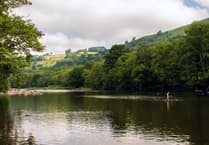COUNCIL leaders have approved a new commission to boost the creation of pollution-busting wetlands, while also helping the building industry.
Herefordshire Council’s bid to make the Wye a ‘Water Protection Zone’ was turned down by UK Environment Minister Rebecca Pow this summer.
But in a world-first, the council is now creating a number of ‘Integrated Wetlands’ to remove phosphates before they reach our rivers, which will also enable the damaging ban on building development in some areas to be lifted.
From this month, the Cabinet is restoring the ‘Wye and phosphates credit scheme’, whereby developers can buy credits generated by the operation of the wetlands to offset the phosphates their new developments will create.
A council spokesperson said: “In this way it is possible to ensure that the overall effect of new development is what’s called ‘nutrient neutral’, similar to the way companies can offset their carbon footprints by planting trees or sponsoring carbon negative projects.”
As part of this, council leaders have launched a ‘Cabinet Commission on Restoring the Wye’, to undertake a “more strategic and systems led review of river quality and in particular to consider how Herefordshire Council can use all the powers and influence available to it to progress the restoration of the Wye and Lugg”.
The council says it has taken a lead role in efforts to support the restoration of the Wye, working through the Nutrient Management Board and investing in a significant national role to progress river restoration.
And Cllr David Hitchiner, Herefordshire Council leader, said last week: “The council has been leading this fight, and following a unanimous council vote, we requested the introduction of a Water Protection Zone covering the River Wye.
“This was rejected by Government, so we are now proposing the establishment of a Cabinet Commission on Restoring the Wye, which will not only gather the evidence required for a Water Protection Zone, but will seek to work as quickly as possible to consult and identify practical options to making a long term difference to the Wye and Lugg.”
Trading in phosphate credits will increase as further Wetlands arrive on stream, and will be allocated on the agreed first come first served policy.
Cllr Hitchiner added: “Excellent progress has been made on our pioneering Integrated Wetlands Scheme.
“For the first time anywhere in the world, wetlands sites will remove phosphate pollution from waste water before it reaches our rivers, and thanks to the credits scheme, developers will be able to purchase credits to offset the impact of their development.
“Not only will this mean an end to the damaging and frustrating ban on development in certain areas, but also that new developments will be ‘nutrient neutral’.
“This is just one example of the practical steps we are taking to restore Herefordshire’s rivers.”
Environmental campaigners have argued over the past two years that the Wye’s eco-systems are being destroyed by phosphate pollution, particularly from a huge growth in intensive poultry farming in Herefordshire and Powys.
But pollution caused by construction has seen the brakes put on new development in parts of the Wye and Lugg catchments as well, with property services firm Lichfields claiming in June it had already cost the county £316m in lost investment.




